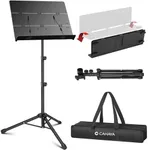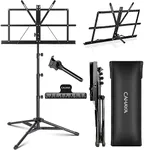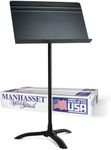Buying Guide for the Best Music Stands
Choosing the right music stand is essential for musicians of all levels. A good music stand will provide stability, adjustability, and ease of use, allowing you to focus on your performance or practice without worrying about your sheet music. When selecting a music stand, consider the following key specifications to ensure you find the best fit for your needs.MaterialThe material of a music stand affects its durability, weight, and stability. Common materials include metal, plastic, and wood. Metal stands are typically more durable and stable, making them suitable for frequent use and professional settings. Plastic stands are lightweight and portable, ideal for students and casual use. Wooden stands offer a classic look and are often used in formal settings. Choose a material based on your usage frequency and the environment in which you'll be using the stand.
AdjustabilityAdjustability refers to how easily you can change the height and angle of the music stand. This is important for ensuring comfort and proper posture while playing. Stands with telescoping shafts and adjustable trays allow for a wide range of height settings, accommodating both seated and standing positions. Look for stands with smooth, easy-to-use adjustment mechanisms to ensure you can quickly and comfortably set up your stand to suit your needs.
PortabilityPortability is crucial if you need to transport your music stand frequently. Lightweight stands that fold down compactly are ideal for musicians on the go, such as students or performers who travel for gigs. Consider the weight and size of the stand when folded, as well as any included carrying cases or bags that make transportation easier. If you primarily use your stand in one location, portability may be less of a concern.
StabilityStability ensures that your music stand remains upright and secure, even when holding heavy sheet music or books. Look for stands with sturdy bases, such as tripod designs, which provide a solid foundation. The construction and weight distribution of the stand also play a role in its stability. If you often use thick music books or perform in windy outdoor settings, prioritize stability to prevent your stand from tipping over.
Tray SizeThe tray size determines how much sheet music or how many books the stand can hold at once. Larger trays can accommodate multiple pages or larger music books, while smaller trays are more compact and lightweight. Consider the type of music you typically use and whether you need extra space for accessories like pencils or page markers. Choose a tray size that comfortably fits your music without overcrowding.
Ease of AssemblyEase of assembly refers to how quickly and effortlessly you can set up and take down the music stand. Stands with simple, intuitive designs and fewer parts are generally easier to assemble. This is particularly important for musicians who need to set up and pack away their stands frequently, such as those who travel for performances or lessons. Look for stands with clear instructions and minimal components to ensure a hassle-free experience.














